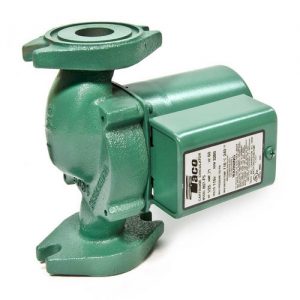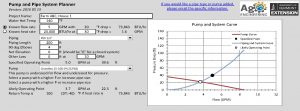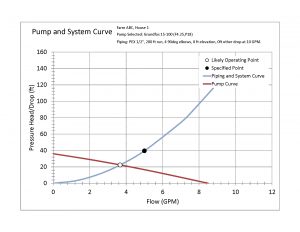
“Will the 007 be enough?” is a common question in early spring as greenhouses around the region fire up and we do our best to keep seed trays and their cargo warm on the still-cool nights. My mind instantly goes to “which movie?” And then I crash back to earth and realize this is a question about pumps and I am not Q.
The 007 is a very common circulator from Taco that we all seem to have among our midden heaps. Wire up some power and thread some pipe into the never-easy-to-find pipe flanges and you’re in business. But will that pump do that job? Just how much flow (gallons per minute, GPM) will result if a certain size line is used? What if I have 86 elbows in the line?
Many times I’m asked to help farmers and processors select a pump or size piping for a specific need. Common applications include bench heating in a greenhouse, running hot water from a boiler to a hot water unit heater, making use of “that old spring up on the hill”, or setting up a solar irrigation system.
We’ve been moving water for years. In the summer I love watching my young son and his friends play with water at the beach. Ok, I’ll admit it. I’m in the thick of it. I’m building the holding ponds and canals of sand. I’m supervising the “bucket crews” to ensure we have steady flow. “We need this ‘fish pond’ deeper over here! Let’s keep Sparky happy.” “We’ve got a break in the wall over there!”
We love moving water, and that is a really good thing. Because life depends on it. I love thinking about pumps and piping and how they play together to do good, honest work for us. The key thing to remember is that flow requires pressure difference; water only moves from one place to another because there is a difference in pressure. Water flows downhill because of “head” pressure created by gravity that acts on the “column” of water. The same thing happens with a human pyramid. A column of water can’t support itself, of course, so it gives way and flows down to where it collects, drains or otherwise moves on.
When I was first introduced to a pump curve I thought is was one of the most amazing things on earth. It brought some certainty and predictability to an otherwise mysterious process. A pump curve is a characteristic relationship of flow and pressure for a given pump (running at a certain speed). Typically it is an actual “curve” plotted in graphic form with flow on the horizontal (X) axis and pressure head plotted on the vertical (Y) axis. It can also be presented as a table of data. A pump generates the highest pressure “head” when there is no flow, and generates the most flow when there is no pressure required. Both of these cases are purely theoretical, all real applications lie somewhere in the middle since flow with no pressure head and pressure head with no flow don’t do anything useful for us. The pump curve helps us know what is going on in the middle so that we can put the pump to use.
The pump curve has a very close friend, the “system curve”. Just as flow doesn’t happen without pressure difference. It also doesn’t happen without pressure loss. The flow of water in a pipe or channel creates friction at the edges. This is why the velocity of a stream or river is higher in the center then it is on at the bank. Luckily for us, this is also a fairly predictable thing if we know something about the fluid being moved, the pipe dimensions and the rate of flow. So pumps and their systems do a dance and find a happy balance of flow and pressure that they can agree on. My friend Ben and I provided a summary of how to use pump and system curves in our article about solar irrigation systems.
When we wrote that article it felt great that we had compiled this information and provided it in a concise article, but I also felt there was more that we could do to help folks “navigate the waters” of pumps and pipes. I know from my own experience that trying to track down pipe dimensions and pump curves is a time consuming and frustrating process. It is challenging even before you get into the math involved in putting the two curves together. So I wanted to make this process easier by creating the pump and pipe calculator.

This calculator has a list of common circulation pumps used for smaller volume systems common on Vermont farms. I have taken their pump curves and put them into the calculator so you don’t have to look anything up. Similarly, I have compiled the dimensions of common piping and tubing in the calculator as well. You enter what you know about the flow required (gallons per minute or GPM). If you know a heat rate (BTU/hr) and temperature change it will calculate the required GPM for you. You also enter what you know about the piping but selecting the pipe type and size and providing some basic information about length of run. All the math is done for you and a simple graph of both pump curve and system curve is presented with two points added on. The first point added on is the the operating point your inputs resulted in (GPM and pressure in “feet head of water”). The second point added is the intersection of the pump and system curves. This is the likely point of operation for the combined system. Based on the difference between these two points, you can adjust you pump and pipe selection until the two points align.

I hope you find this new tool helpful and ask that you provide feedback to help improve it.